|

|
|
 |
-
 |
 |
|
In 2016, Coastal 181 is working hard
on
three book projects:
|
RON BOUCHARD: Remembering the Kid
from Fitchburg, which celebrates the life
and racing career of the late Ron Bouchard. We
will launch this book on August 10 at Thompson
Speedway, where Ronnie had many victories and
was a track champion. We will have an autograph
and book-signing session with the author, Bones
Bourcier, and a number of the driving legends
who participated in the book.
A extensive
history (title yet to be finalized) of the Wood
Family and NASCAR's Wood Brothers Racing team,
by Buz McKim and Mark Moskowitz. This one will
be out for the fall.
A memoir, which
promises to be wild and wacky, that Lew Boyd is
co-writing with open-wheeler Kevin Olson, due
October.
We'll be posting more
information as the books take shape, but here's
some information about our memoir of Ronnie
Bouchard.
RON BOUCHARD:
Remembering the Kid from Fitchburg
Compiled and edited by acclaimed motorsports author Bones
Bourcier, the book recalls Bouchard through the
eyes of rival drivers, teammates, promoters,
friends, and family members. The format is much
like what Bones created in our book on stand-out
racer Ed Flemke, Steady Eddie.
Contributors include Modified icons Bugs Stevens
and George Summers, legendary car owners Bob
Johnson and Bob Judkins, NASCAR Cup winners
Geoff Bodine and Ricky Rudd, broadcasters Jack
Arute and Mike Joy, and many more. All share
personal memories of Ronnie B., who had a grin
made for victory lane and enough talent to get
him there often.
Bouchard took his first
checkered flag at age 14 - having fibbed his way
into the starting field at a long-gone New
Hampshire oval - and his last at one of stock
car racing's toughest tracks, Darlington
Raceway. In between came so many triumphs that
he had no idea of the total; Ron's answer to
that often-asked question was "up in the
hundreds, easy."
Though best known
nationally for his stunning upset in the 1981
Talladega 500 and the NASCAR Cup Series Rookie
of the Year honors that followed, the
Massachusetts native was one of his generation's
most accomplished short-track drivers.
Bouchard's style blended brains and brawn;
whether contesting a frantic 30-lapper or a
long-distance show requiring strategy and
patience, he was always in the mix. He won
Modified races from New England to Florida,
including major events at Martinsville Speedway
in Virginia, Pocono Raceway in Pennsylvania, and
New York's Oswego Speedway. Along the way came
multiple track championships, and legions of
fans drawn in by that winning smile. |
 |
.jpg) |
|
ORDER HERE |
Twenty years after they hung up their
helmets, the names A.J. Foyt, Mario Andretti,
and Richard Petty remain synonymous with the
sport they carried to new heights. They rose to
fame just as the American media began to
legitimize auto racing, and gave the nation
characters as compelling as any in sports or
entertainment.
Foyt was all Texan, John
Wayne in a firesuit, stomping into victory lanes
from Indianapolis to Le Mans. Petty, the genial
North Carolinian, put a smiling Andy Griffith
face on the American South, no small feat in the
tumultuous '60s. Andretti, who'd sailed from
Italy at age 15, struck for all outsiders the
same yes-you-can chord sounded by another
ambitious Italian-American, Frank Sinatra.
They crossed paths often, on-track and in
the headlines. Take 1967, which opened with
Andretti beating NASCAR's best at Daytona,
peaked with Foyt's third Indy 500 win, and ended
with a record 27 victories for Petty. Or the
three-season stretch from 1977-79, when Foyt
became the first four-time Indy winner, Andretti
earned the World Driving Championship, and Petty
won a game-changing Daytona 500. They even
throttled back their careers in lockstep, Petty
in 1992, Foyt in '93, Andretti in '94. Today all
three are revered; as they walk through crowded
pit areas, people make way. Charisma never ages.
This is more than a three-act biography.
Laced with quotes from Foyt, Petty, Andretti,
and their peers, and spiced with period accounts
from the motorsports world and the changing
social landscape, this is the history of modern
American racing as refracted through the lives
of three extraordinary champions. Further
context is added by a pair of forewords, one by
motorsports broadcaster Dave Despain, the other
by acclaimed driver John Andretti, who grew up
as Mario's nephew, raced for both Foyt and
Petty, and also happens to be A.J.'s godson.
The book is hard cover, 348 pages, including
24 pages of photographs. |
 |
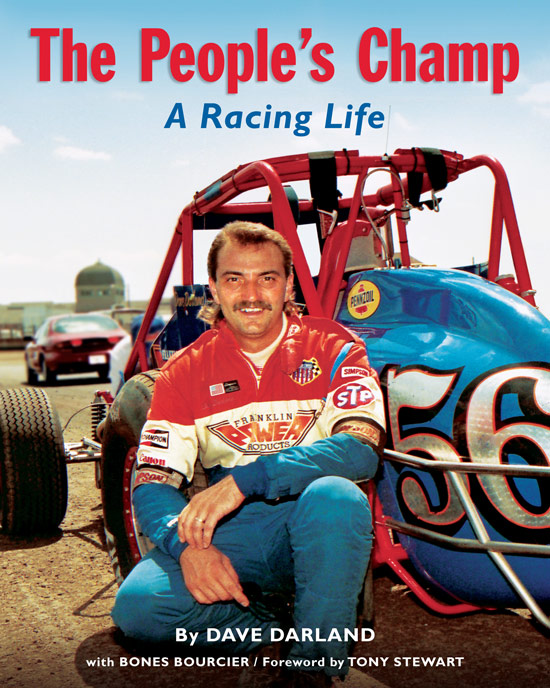 |
Dave Darland at the Springfield Silver
Crown race on August 16, 1997,
during his
title-winning season. (John Mahoney Photo) |
|
ORDER HERE |
-
192 pages plus 32 pages
of black and white and color photos, documenting
Dave’s remarkable path into the history books,
including his winning ways in 2014. |
One of contemporary open-wheel racing’s
most extraordinary careers will be celebrated
late this spring with the release of “The
People’s Champ: A Racing Life,” the
autobiography of United States Auto Club
superstar Dave Darland, co-authored by veteran
motorsports journalist Bones Bourcier.
The title comes from the nickname that rings
from track loudspeakers whenever Darland is
introduced. It’s not something the Indiana
driver made up himself – in fact, just hearing
it almost makes him blush – and it sure wasn’t
dreamed up by some fancy marketing team. But it
certainly fits, as evidenced by the applause
those introductions generate at dirt and paved
speedways from coast to coast.
One of the
few drivers to win USAC championships in all
three of the sanctioning body’s national
divisions – Silver Crown, Sprint Cars, and
Midgets – Darland has conquered tracks of all
sizes, from the quarter-mile bullrings dotting
his home state to the Midwestern fairgrounds
miles that are so much a part of USAC’s rich
history. And at age 47, he shows no sign of
slowing down: In 2013 he won two of USAC’s
richest Sprint Car races, the Oval Nationals at
California’s Perris Auto Speedway and the Kokomo
Smackdown at the track he calls home, the Kokomo
Speedway north of Indianapolis. He capped his
season with a Thanksgiving victory in one of
Midget racing’s marquee events, the Turkey Night
Grand Prix, also at Perris.
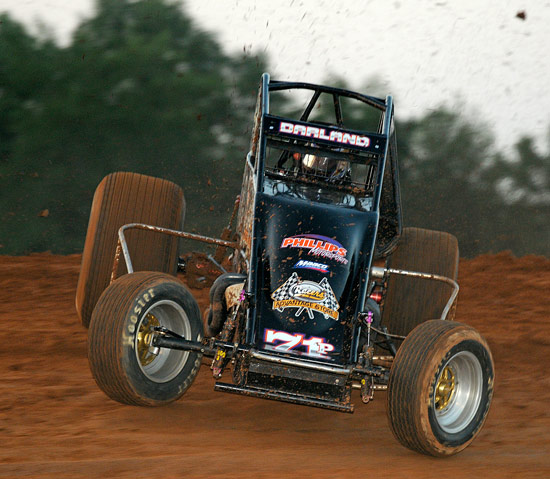
Bloomington, July
2013 (John Dadalt photo) |
Told in
Darland’s own words, the book charts the course
of his racing life, from Quarter-Midgets and
local Sprint Cars through his remarkable
professional career, including four USAC
national championships: Silver Crown in 1997,
Sprint Cars in ’99, and Midgets in 2001-02.
Naturally, there are plenty of tales about his
success on Indiana’s fierce weekly racing scene,
where his loyal fan following sprouted and then
blossomed.
But this is no mere
chronological rehashing of a great driver’s
climb. Among other things, Darland discusses the
rivalries that helped shape his career, the code
of conduct he insists on racing by, the magic of
his sport’s biggest events, and the joys and
stresses of being a husband and father in a
sport that requires frequent travel and intense
focus.
And, yes, he describes for readers
both the honor and the responsibility involved
in lugging around that hard-earned title: The
People’s Champ.
As a bonus, the book is
annotated with reflections from “eyewitnesses”
who have seen Darland through the prisms of
their own personal and professional
relationships, whether as car owner, mechanic,
rival driver, or family member. Darland’s story
is illustrated by dozens of photographs, many
previously unpublished.
This is the tenth
book for Bourcier, and his seventh with Coastal
181. His most recent works were the widely
acclaimed autobiographies of Indianapolis 500
hero Parnelli Jones (entitled “As a Matter of
Fact, I AM Parnelli Jones”) and Supermodified
legend and Little 500 winner Bentley Warren
(“Wicked Fast”).
Keep an eye on
www.Coastal181.com for further details.
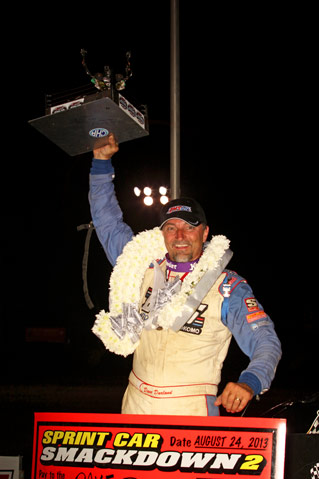
Kokomo Smackdown,
August 2013 (Randy Jones photo) |
|
 |
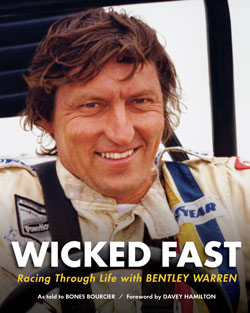
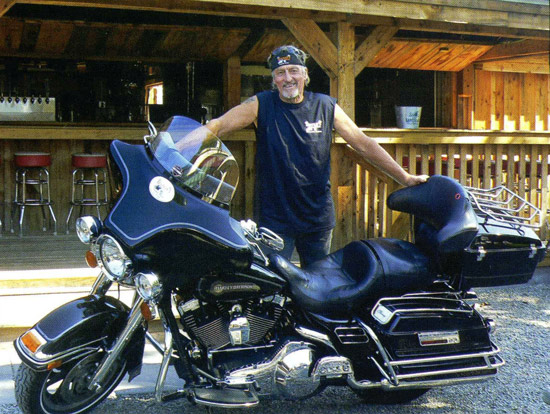
(Bentley
Warren Collection) |
|
- |
WICKED
FAST: Racing Through Life with Bentley Warren
by Bones Bourcier |
This project is a case study in why book
publishing can be fun. How about taking on one
of the last truly great characters in American
racing?!
Since early this year, Bones
Bourcier has been bouncing around from Daytona
to Arundel, Maine, chasing down that legendary,
but ever-moving figure, Bentley Warren.
Everyone will tell you he’s Bentley’s buddy.
Whether in the pits at the races or among
hundreds of bikers gathered each weekend at his
Saloon, he is always the center of attention.
But, when all is said and done, how many
people really know Bentley? It’s Bones’ mission
to dig deep into this amazing guy who can go
wicked fast in any kind of race car made, zip
across the country on the Harley from Hell at a
moment’s notice, or win over the most
sophisticated of the business world, while still
dressed in his ripped jeans and biker tee.
WICKED FAST: Racing Through Life with
Bentley Warren covers all of Bentley’s
amazing journey and features hundreds of racing
images. |
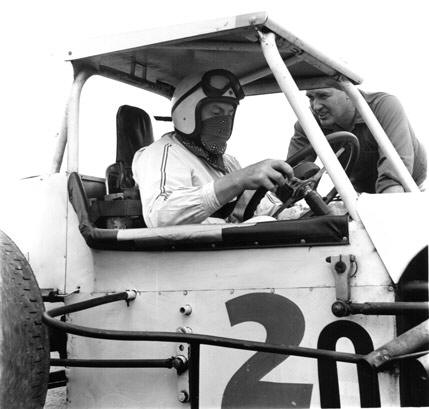
(Dick
Berggren Collection) |
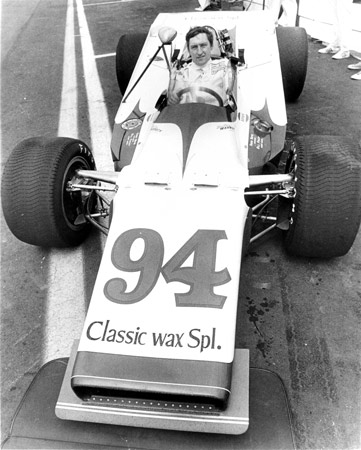
(John
Lengenfelder Collection) |
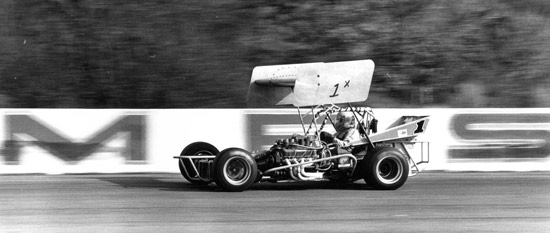
(Terry
Bourcy Photo, Dick Berggren Collection) |
 |
|
. |
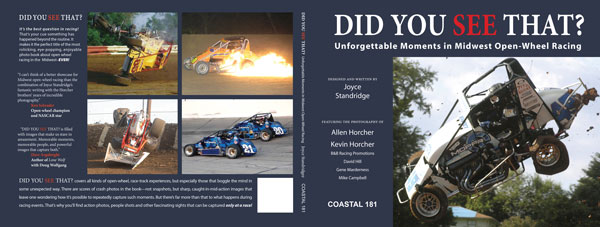 |
|
Order HERE |
Did You See That?
by Joyce Standridge |
A few years ago, Coastal 181 published
Win It or Wear It—All-Time Great Sprint Car
Tales. In the process of developing
that book, the team discovered the extraordinary
talent of photographers Allen and Kevin Horcher,
brothers who have captured incredible images
from around the Midwest over the past 35 years.
While we could use only their sprint car shots
in that book, it was clear that their portfolios
included all kinds of open-wheel images such as
never had been published before.
Fast
forward to 2013 and it’s time to share those
amazing photos with racing fans everywhere,
coupled with the light-hearted and insightful
captions that only award-winning writer Joyce
Standridge could bring to the project, and
supplemented with additional remarkable photos
by David Hill, B&B Racing Promotions, Gene
Marderness and Mike Campbell.
“Did You
See That?” is the perfect title for a book that
covers all kinds of race-track experiences, but
especially those that boggle the mind in some
way. There are scores of wreck and crash photos
in the book—not snapshots, but sharp,
caught-in-mid-action images that leave one
wondering how they repeatedly managed to do
that. But there’s more than that to what happens
during racing events, so there are also action
photos, people shots and other fascinating
sights that can be captured only at a track.
Scheduled for release in the fall of 2013,
the book features photos from 1978 to the
present, encompassing some two dozen Midwestern
tracks showcasing Midgets, Sprints and Silver
Crown cars. This book is a must-have for all
racing fans, whether diehard or not. It’s not
even necessary to be an open-wheel fan to
appreciate the art from unique moments in racing
history. |
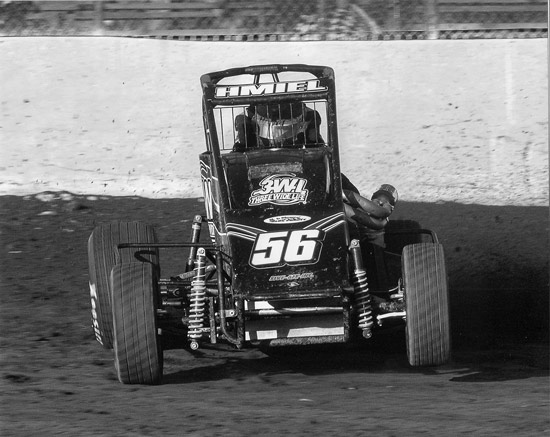
(Allen
Horcher Photo) |
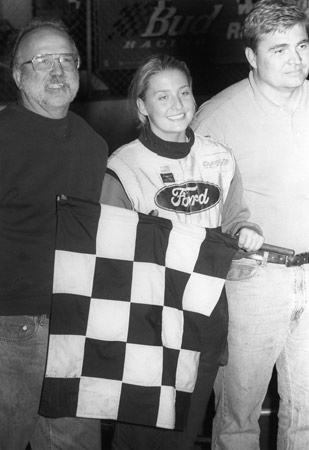
(Kevin Horcher
Photo) |
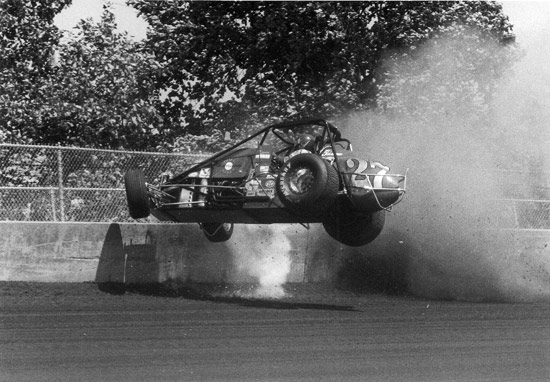
(Kevin Horcher
Photo) |
 |
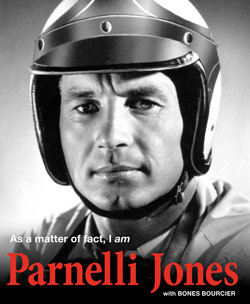
As a
matter of fact, I AM
PARNELLI JONES |
We are pleased to
announce that Coastal 181 released a memoir
of Parnelli Jones in December 2012. Written with
Bones Bourcier, each chapter starts with a
preface by Bones to set the scene, continuea with
remembrances by Parnelli of a particular chapter
of his life, and enda with a “Testimony” by
someone who was there. Those “someones” include
racers like Mario Andretti, Al and Bobby Unser,
A.J Foyt, Johnny Rutherford, and many more, as
well as intimate reminiscences from Parnelli’s
sons Page and PJ.
Available for purchase here. |
|
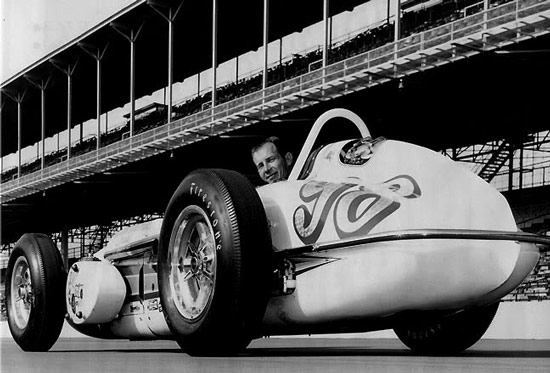 |
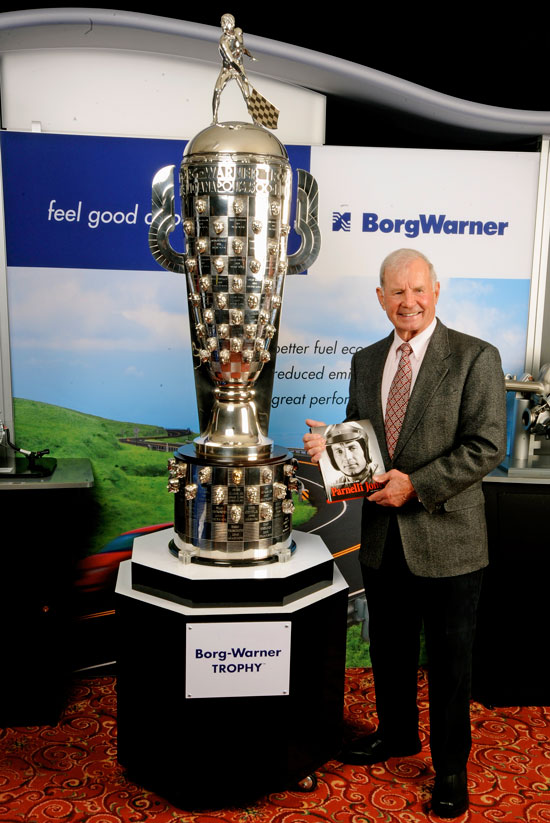 |
|
On his way to the Area Auto Racing
Motorsports 2013 show, Parnelli Jones stopped in
Detroit to present his friend and mentee Dario
Franchitti with a "Baby Borg" trophy,
commemorating Dario's 2012 victory in the Indy
500. But everyone involved had a wee surprise
for Mr. Jones. When Dario finished his
acceptance speech, he turned to Parnelli and
said, “Now it is time for yours.” Fifty years
earlier Parnelli had won the Indy 500, but the
tradition of giving an 18-inch tall “Baby Borg”
to the winner wasn’t started until 1988. As you
can see, Parnelli, shown here with the full
Borg-Warner trophy and holding
his new book, was very pleased! (Photo
Courtesy Borg-Warner) |
|
For race fans of a
certain age, or those in touch with the sport’s
history, Parnelli Jones is synonymous with
speed. His rise from dirt-track jalopy battles
to victory lane at the Indianapolis 500 is the
stuff of American motorsports legend.
Now, at long last,
Parnelli tells the story of his incredible
racing life. It’s all here: the hungry days as a
traveling Sprint Car driver, the danger and
glamour of Indy Car racing’s Championship Trail,
the thrilling NASCAR victories, the Trans-Am
road-racing titles, the bumpy rides to Baja 1000
glory, the magnificent triumphs and searing
tragedies he witnessed along the way.
There was a time
when every speed-trap cop in the land would
greet a typical offender by growling, “Who do
you think you are, Parnelli Jones?” And one day,
on a Los Angeles freeway, our hero handed over
his driver’s license and replied, “Well,
officer, as a matter of fact …”
From winning
Indianapolis aboard his Ol’ Calhoun roadster to
losing it with the famous STP turbine car ….
From Oklahoma Dustbowl roots to a richly
appointed businessman’s office in Los Angeles …
From scuffling for rides to owning American
racing’s first “Superteam” … Parnelli has been
there and won that. Come along for the ride as
he steers you through his amazing journey. |
 |
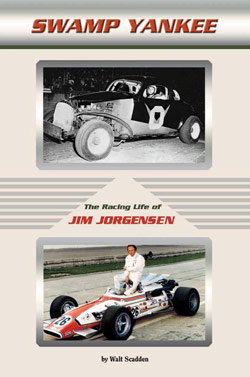 |
BOOK RELEASED ON LEGENDARY JIM JORGENSEN
AND
AUTO RACING’S GREATEST ERA |
Newburyport, Mass., July 25, 2012 – Motorsports
publisher Coastal 181 announced today the release of their
latest title, “Swamp Yankee: The Racing Life of Jim
Jorgensen,” by Walt Scadden.
“Swamp Yankee” is the
story of legendary crew chief and engine-builder Jim
Jorgensen’s epic journey from Riverside Park Speedway in
Agawam, Mass., to the National Championship Indy Car Series.
From the late 1950s to 1969, Jorgensen and his crew
crisscrossed the country, racing his innovative stock car,
sprint, and Indy Car designs with standout drivers like Gene
Bergin, Buddy Krebs, Bill Brown and Denny Zimmerman.
Progressing from countless bullrings and county fair tracks
to some of the most revered venues in the country such as
Langhorne, Phoenix and Milwaukee, and on to the Indianapolis
Motor Speedway, Jorgensen made his name and left his mark.
His journey had its share of detours and heartbreaking
disappointments, but it provided him the formidable
education needed to compete at the highest level of racing
in the country and earned him induction into the New England
Auto Racing Hall of Fame.
Jorgensen’s was a time of
open trailers and pick-up trucks, where a handshake was the
measure of a man. His story is a compelling account of the
ingenuity, passion, triumph and hardship that defined the
legendary competitors of racing’s greatest era.
“Swamp Yankee” will be launched at the 12th Annual CRUISIN’
ON MAIN STREET Car Show on August 5th in Manchester, Conn.,
and is also available through Coastal 181, 29 Water St.,
Newburyport, Mass. 01950. www.coastal181.com, 877-907-8181
toll free. The book is soft cover, 152 pages, and is priced
at $19.95.
More on “Swamp
Yankee” HERE. |
|
.- |
|
Swamp Yankee: The Racing Life of Jim
Jorgensen |
We are currently working on a biography
of Connecticut race car builder/owner and NEAR
Hall of Fame member Jim Jorgensen. Swamp
Yankee: The Racing Life of Jim Jorgensen,
written by Walt Scadden, recounts Jorgensen’s
progression from the gritty days of Modified
racing at Riverside Park in Agawam,
Massachusetts, where he fielded the famous
“Flying Zero” for stars like Gene Bergin and
Buddy Krebs, all the way to Indy in 1969, where
he missed qualifying by one spot and tenths of a
second.
The traveling distance from “The
Park” to the Indianapolis Motor Speedway is a
little short of 900 miles. The journey took
Jorgensen a decade. The trip had its share of
detours and heartbreaking disappointments but
provided him the formidable education needed to
compete at the highest level of racing in the
country.
In addition to his career as a
car owner, Jim Jorgensen became famous
throughout Southern New England and beyond for
his advancements in engine-building. John
McCarthy, former NEMA president and one-time
operations director of New Hampshire Motor
Speedway, often credited Jorgensen as “the
innovator of the great Chevy-II stock block
Midget engine.”
Author Walt Scadden has
had a lifelong involvement in motorsports, and
his knowledge and love of racing is both broad
and deep. He has built or worked on race cars in
every form of the sport, from road racing to
speed-runs on the salt at Bonneville. Walt is the author of two previous books,
Vintage Hot Rod Metal Work and
Old School Hot Rod Projects.
Swamp Yankee is scheduled for release
midsummer 2012. |
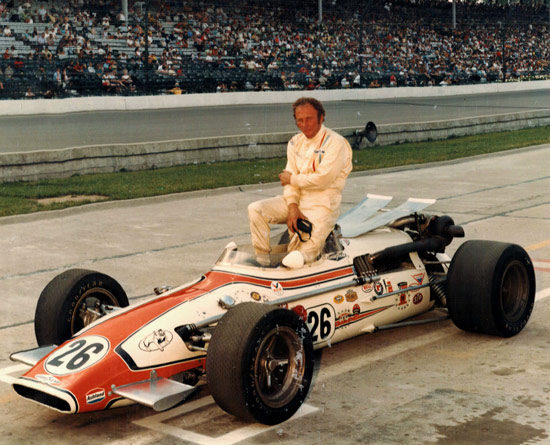 |
Rick Muther in the Jorgensen #26 during
qualifying for the 1969 Indy 500.
(Jim
Jorgensen Collection) |
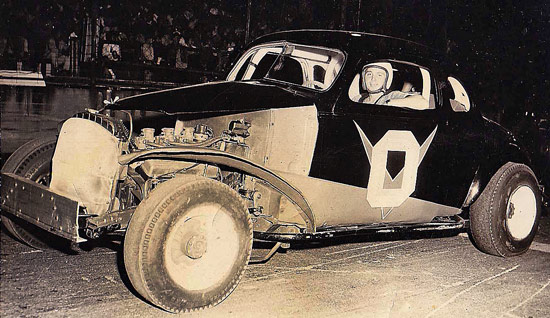 |
Gene Bergin in the Flying Zero at
Riverside Park, late 1950s or early 1960s.
(Jim Jorgensen Collection) |
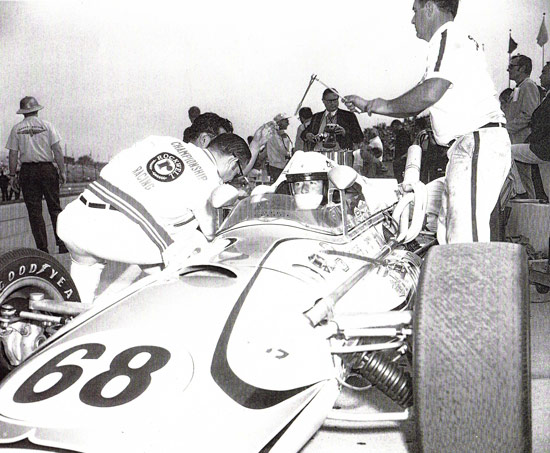 |
Denny Zimmerman in the Bulldog Stables
#68, getting ready for his rookie test
at
Indy in 1969. This was Jorgensen’s favorite car.
(Jim Jorgensen Collection) |
 |
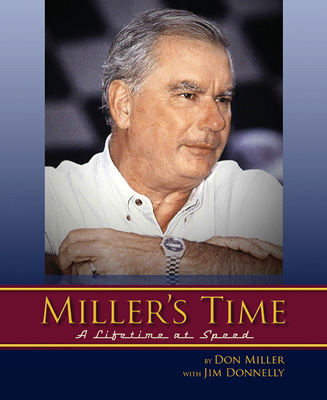
NOW ON SALE HERE |
|
|
Miller's Time - A Lifetime at Speed
You know who Roger Penske
is. You know Rusty Wallace and Ryan Newman. You
know they’ve won enough races and championships
to fill up a freight train. Without Don Miller,
a lot of those triumphs might have never
happened.
It's impossible to overstate how important Don
Miller has been at the pinnacle of American
racing, and how influential he is on so many
levels. He has been an elbow-to-elbow advisor
and confidant to Penske on racing matters since
the early 1970s. Miller brought Goodyear to
dominance in Midwest short-track racing. As a
mentor, he turned both Wallace and Newman from
unknowns into superstars. He represented a
couple of dozen huge corporations in auto racing
and made them successful. Don Miller can even
take credit for inventing the souvenir trailer.
A professional drag racer in his teens and
twenties, Miller has always been the hardest of
hardcore racers, on every kind of track. That
passion has never diminished, even though racing
brought him to the very abyss of death.
Don Miller has never told his story until now.
Miller's Time, the memoirs of this hot
rodder, racing titan, gifted businessman and car
collector who just plain loves people, is one of
the most compelling, rewarding and harrowing
racing books that you will ever be lucky enough
to read. It can honestly change your life.
|
|
“SOAPBOX” FOR AREA AUTO
RACING NEWS
BY JOHN SNYDER
(Excerpted from AARN SOAPBOX for April 27, 2010)
I have a pretty extensive racing
library, but the latest addition to it is unlike
any other book in my collection. That’s because
it’s not about a driver, or track, or race, or
race series, or promoter, or history or any of
the usual subjects of motorsports texts. Instead
Miller’s Time: A Lifetime at Speed is
part autobiography, part philosophy, part how-to
build a race team, and part a look into the
inner workings of one of the most successful
organizations in the sport’s history.
Miller’s Time is Don Miller’s story,
with help from Hemmings senior editor and my
good friend Jim Donnelly. Miller, a hot rodder
from Chicago, turned a life-long passion for
automobiles and speed into an amazing career
that took him from drag racing on city streets
to key sales and marketing positions with Sears
and Goodyear and then to partnerships with Roger
Penske and ultimately with Rusty Wallace the
formation of Penske South NASCAR (then) Winston
Cup team.
Along the way, Miller relates
the struggles he faced, including a 1974 pit
road accident at Talladega that nearly cost him
his life and did result multiple injuries and
the amputation of his right leg.
A good
portion of the book---and some of its most
interesting pages---deals with Miller’s
fostering the careers of Rusty Wallace and later
Ryan Newman. Of Wallace, Miller says, “What
brought me to Rusty was his incredible fire,
this blaze in his gut. I knew he would be
successful if somebody gave him some guidance,
because he always gave 140 percent, always. It
was amazing. I had never met anyone up to that
point who wanted to win as much as Rusty did.”
While Wallace had come from the late model
stock car circuits mostly in the Midwest,
Newman’s background was in open-wheel cars. But
midget racing rivals stock cars in that region
and Miller paid close attention to the USAC
Midget races and drivers. “Keeping track of
potential future talent was part of my job at
Penske South…I was following the Big Five in the
USAC Midgets, the guys who were really hot rods,
which had consisted of (Jeff) Gordon, Tony
Stewart, Kenny Irwin, Jason Leffler, and Ryan
Newman,” says Miller.
“To this day, I
believe that the drivers who race Midgets have
the best car control of any racers in
America…I’d seen Ryan drive, at least on
videotape, and know that he had a tremendous
ability to precisely control these tiny,
featherweight, wildly overpowered race cars.”
Miller officially retired from Penske South
at the end of the 2007 season, but retirement
isn’t a real word in his vocabulary. He still
keeps his eye on what happening with Penske’s
wide-flung operations, but devotes much more of
his time to Stock for Tots, Stop Child Abuse
Now, and the North Carolina Auto Racing Hall of
Fame. In fact, net proceeds from the sale of
Miller’s Time have been pledged to support
the prevention of child abuse and neglect in
North Carolina.
Miller’s Time is
greatly enhanced by the liberal use of quotes
from others whose paths have crossed his own and
dozens and dozens of great photographs that
match the text. And that text is crisp,
informative but never preachy, and often giving
small insights into creating successful
enterprises, race teams included. Once you start
it, it’s a hard book to put down.
Miller’s Time is available through Coastal
181 and other outlets.
I highly
recommend it. |
|
“Indeed, It Was
Miller Time”
By
Mike Hembree, Foxnews.com May
31, 2010
The Charlotte Motor
Speedway garage area became a much brighter
space last Saturday the minute that Don Miller
walked through the gate.
Miller, retired
president of Penske Racing South and a racer
virtually since kindergarten, made an
all-too-rare appearance at Penske’s Kurt Busch
hauler, and the parade began. Over the past
quarter-century, few garage-area residents have
been as popular as Miller, and his visit to CMS
attracted a long line of crewmen, officials,
public relations people and journalists anxious
to catch up on his latest exploits.
Miller didn’t take
credit for it, but, later that evening, Penske
driver Kurt Busch won the Sprint All-Star Race.
It seemed only appropriate, and such
circumstances might force Miller to show up at
the track more often.
A long-time Penske
lieutenant, Miller finally was able to
officially remove himself from the sport in
2007. He had been on the road in numerous racing
jobs and positions (most Penske-related) for
decades, and it was past time, he said, to spend
some quality days kicking around with his
grandchildren. Many people who retire from busy
jobs say that’s their aim; Miller has actually
done it.
Another thing
Miller has done since his retirement from
running Penske’s stock car operations is
something he should have done – write a book.
Although Miller’s name generally is not known
among the wide spectrum of race fans, he has
been a force in racing since a relative’s
souped-up hot rod first got his attention as a
kid in Chicago.
He got into drag
racing as soon as he could afford it, eventually
put himself in position to make money from
racing in a variety of jobs and then met Penske.
He, Penske and Rusty Wallace eventually put
together the deal that returned the Penske name
to NASCAR, and they built the foundation for the
Penske Racing operations that now are housed in
a fabulous facility in Mooresville, N.C.
Miller became a
tutor of sorts for both Wallace and later Ryan
Newman, whose quick rise in NASCAR can be
traced, in large part, to Miller’s smarts.
Miller had his
hands in many things over the years, including
the early development phase of stock-car roof
flaps and the ground-floor design of the Taurus
model Ford teams formerly raced.
Those stories and
many others are retold in “Miller’s Time: A
Lifetime At Speed,” a book Miller wrote along
with Jim Donnelly. To Miller’s credit, proceeds
from the book will go to assist abused children
in the Carolinas, a cause he has long supported.
The fact that
Miller is around at all is rather amazing. In
May 1974, he survived one of the worst pit-road
accidents in NASCAR history. He was serving as
the catch-can man in the Penske pits when a car
driven by Grant Adcox smashed into the rear of
Penske driver Gary Bettenhausen’s car while it
was being serviced. Miller was caught between
the cars and then was slammed into the pit wall.
His right leg was
virtually cut off in the accident, and rival
crewman Buddy Parrott, working nearby, raced
over and applied a tourniquet to cut the
bleeding, a move that probably saved Miller’s
life.
The brutal accident
left Miller with the mangled right leg, a broken
left leg, a broken back, a pelvis broken in
three places and other injuries. He went through
months of rehabilitation and years of surgeries
and still deals with the effects of the accident
35 years later.
No one would have
blamed Miller if he had traded racing for
raising petunias after the Talladega trauma and
its aftermath. Instead, with Penske’s
encouragement and the support of family and
friends, he worked through the recovery and
returned to racing to become one of the most
important people in the business.
“I’ve learned to
live with it,” Miller said. “There always are
plenty of reminders of the operations I’ve had –
all the nuts, bolts, screws, pins and all that
that are around. It’s always something.
“But it’s all done.
I take the high road.”
Now 70, he still
wanders over to the Penske shop occasionally to
keep up with the goings-on. But much of his time
is spent tinkering on hot rods for his
grandchildren. He’s a “car guy” who wants to
nurture other car guys, and he wants it done
safely and sanely. |
|
|
.jpg)
Bobby Allison and Don Miller have a lot in
common:
Both legends in racing, both wonderfully decent
guys.
(Penske Corporation photo, Don Miller
Collection) |
|
|
.jpg)
Don Miller is the guy who took a super-talented
short-track driver named
Rusty Wallace, made him into a national star, a
Winston Cup champion,
and then built a team around him with Roger
Penske.
(Kenny Kane Photo, Don Miller Collection) |
|
|
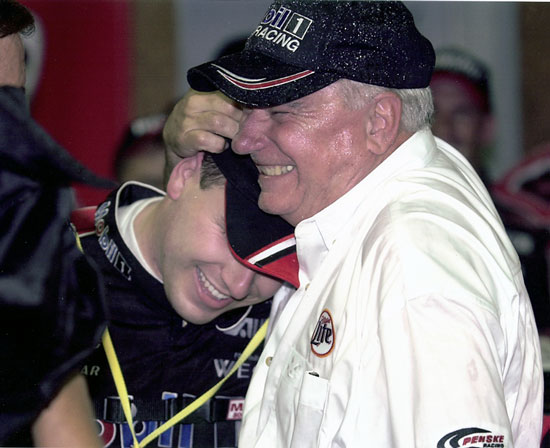
Don and Ryan Newman, celebrating an early win.
(Don Miller Collection) |
|
|
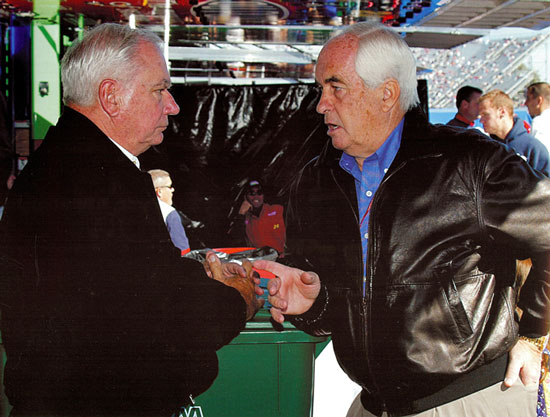
Don Miller and Roger Penske – strategists,
partners and friends.
(Steven Rose photo, Penske Corporation
Collection) |
|
|
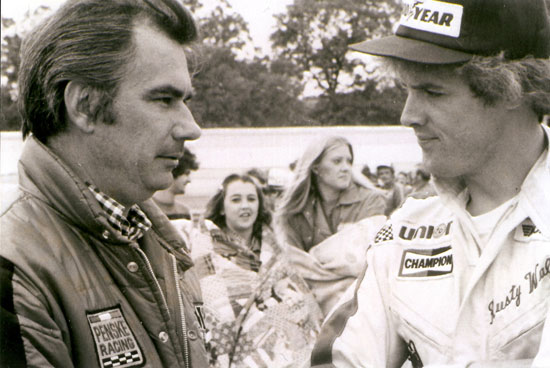
Don with Rusty Wallace, testing at
Atlanta in 1980. Don
Miller
– one of the best mentors a talented young racer
could have.
(Penske
Corporation photo, Don Miller Collection) |
 |
|
|